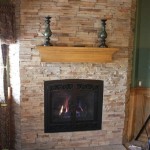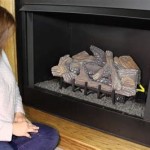Hanging a TV on a Rock Fireplace: Considerations, Challenges, and Solutions
Mounting a television above a fireplace, particularly one constructed of rock, presents a unique set of challenges compared to standard wall installations. While the aesthetic appeal of this setup is undeniable, careful planning and execution are crucial to ensure both the television's safety and the structural integrity of the fireplace. This article will explore the key considerations, potential hurdles, and practical solutions involved in hanging a TV on a rock fireplace.
The allure of combining the warm ambiance of a fireplace with the entertainment value of a television is strong. This arrangement often maximizes space and creates a focal point in a living room. However, the inherent nature of rock, its uneven surface, and the proximity to a heat source necessitate a cautious and informed approach. Ignoring these factors can lead to structural damage, electrical hazards, and ultimately, a compromised viewing experience.
Assessing the Suitability of the Fireplace for TV Mounting
Before embarking on the project, a thorough assessment of the rock fireplace is paramount. This involves evaluating several critical factors. First and foremost is the type of rock used in the fireplace's construction. Some rock types are more porous and prone to cracking or crumbling under stress, making them unsuitable for supporting the weight of a television. Softer rock like sandstone is generally less desirable compared to denser materials like granite or slate. A geological assessment, while potentially costly, can provide valuable insight into the rock's composition and structural integrity.
The method of construction also plays a significant role. Is the rock veneer adhered to a supporting wall, or is it a solid, load-bearing structure? Veneer fireplaces often have a layer of brick, concrete, or wood behind the rock, which may offer more secure anchoring points. However, the integrity of the veneer attachment itself must be verified. A solid rock fireplace, on the other hand, requires specialized drilling and anchoring techniques to ensure a stable mount. Understanding the underlying construction method is essential for choosing the appropriate mounting hardware and installation strategy.
Another crucial aspect is the size and weight of the television. Larger, heavier televisions exert more stress on the mounting point. It's necessary to calculate the total weight of the television, including any mounting brackets, and compare this against the estimated load-bearing capacity of the fireplace. This often involves consulting with a structural engineer or experienced contractor, especially if the fireplace's construction is uncertain or the television is particularly heavy. Overestimating the load-bearing capacity can have disastrous consequences.
Finally, consider the surrounding environment. Is there sufficient clearance between the top of the fireplace and the television to prevent overheating? Fireplaces generate significant heat, which can damage electronic components. A general guideline is to maintain at least 12 inches of clearance, but this may vary depending on the fireplace's design and the television's heat tolerance. Additionally, consider the viewing angle from various seating positions in the room. Mounting the television too high can lead to neck strain and an uncomfortable viewing experience. Careful planning and measurement are essential to optimize both safety and ergonomics.
Addressing Heat and Ventilation Concerns
The heat generated by a fireplace is a significant concern when mounting a television above it. Excessive heat can damage the television's internal components, shorten its lifespan, and even pose a fire hazard. Therefore, mitigating heat exposure is a critical aspect of the installation process.
As mentioned previously, maintaining adequate vertical clearance between the fireplace and the television is crucial. This allows for natural convection of heat away from the electronic device. However, in some cases, this alone may not be sufficient. Strategies for further heat mitigation include installing a mantel shelf above the fireplace. The mantel acts as a barrier, deflecting rising heat away from the television. The depth of the mantel should be sufficient to provide effective protection, generally extending at least a few inches beyond the face of the fireplace.
Another option is to install a heat deflector above the fireplace. These are typically made of metal and are designed to redirect heat away from the television. They can be custom-made to fit the specific dimensions of the fireplace and television. Heat deflectors are particularly useful when vertical clearance is limited or the fireplace generates a significant amount of heat. It is crucial to choose a deflector made of a non-combustible material and to ensure it is properly installed to prevent it from becoming a fire hazard itself.
Beyond physical barriers, improving ventilation is also essential. Ensuring adequate airflow around the television helps dissipate heat and prevent it from accumulating. This can be achieved by leaving space behind the television and avoiding enclosing it in a tight cabinet or recess. Consider using a full-motion mount, which allows the television to be pulled away from the wall, further improving ventilation. Regularly cleaning the television's vents can also help maintain optimal airflow. Consider the long-term implications of using the fireplace and television simultaneously. Reducing the intensity of the fire or using the fireplace less frequently during television viewing can also help minimize heat exposure.
Selecting the Right Mounting Hardware and Installation Techniques
The choice of mounting hardware and the installation techniques employed are crucial for ensuring the secure and stable attachment of the television to the rock fireplace. Selecting the wrong hardware or using improper installation techniques can lead to disastrous consequences, including the television falling from the wall.
Given the uneven surface of most rock fireplaces, standard drywall anchors are generally unsuitable. Instead, specialized anchors designed for masonry applications are required. Options include sleeve anchors, wedge anchors, and concrete screws. The choice depends on the type of rock, the underlying construction, and the weight of the television. Sleeve anchors are suitable for lighter loads and can be used in a variety of masonry materials. Wedge anchors provide a stronger grip and are ideal for heavier loads and denser rock. Concrete screws are a versatile option that can be used in both solid and hollow masonry.
Before drilling any holes, it is essential to carefully plan the location of the mounting bracket. Use a level to ensure the bracket is aligned correctly and mark the drilling points accurately. Drilling into rock requires specialized drill bits designed for masonry. These bits are typically made of carbide or diamond and are more durable than standard drill bits. Use a hammer drill to create pilot holes for the anchors. The depth of the holes should be slightly greater than the length of the anchors to allow for proper expansion.
When inserting the anchors, follow the manufacturer's instructions carefully. Ensure the anchors are fully seated and tightened to the specified torque. Avoid over-tightening, as this can damage the rock or strip the threads of the anchors. Once the mounting bracket is securely attached to the wall, carefully mount the television to the bracket, following the manufacturer's instructions. Ensure the television is level and stable before releasing it. Periodically inspect the mounting hardware to ensure it remains secure and tight. Over time, vibrations and temperature fluctuations can cause the anchors to loosen. Re-tightening the anchors as needed will help maintain the stability of the television.
Wiring management is another crucial aspect of the installation process. Concealing the power cord and other cables will improve the overall aesthetics of the installation and prevent tripping hazards. Options include running the cables behind the wall, using cable management sleeves, or installing a power outlet behind the television. If running cables behind the wall, ensure they are rated for in-wall use and comply with local building codes. If using cable management sleeves, choose a color that blends in with the surrounding décor. A carefully planned and executed wiring solution will contribute to a clean and professional installation.

Mounting A Tv Above Fireplace With Full Tutorial Fixthisbuildthat

Hanging A Tv On Rock Wall

Mounting A Tv Above Fireplace With Full Tutorial Fixthisbuildthat

Mounting A Tv Above Fireplace With Full Tutorial Fixthisbuildthat

Mounting A Tv Above Fireplace With Full Tutorial Fixthisbuildthat

Natural Stone Fireplaces With Wall Mount Television Design Ideas

Fireplace Remodeling Options Classic Home Improvements Decoración De Unas Diseño Chimenea Decoraciones Casa

Made How To Mount A Flat Screen Tv On Stone Fireplace Diy

Installing A Tv Wall Mount On Stone Fireplace Lhp

Mantelmount How To Mount Your Tv Above A Fireplace Infarrantly Creative
Related Posts








